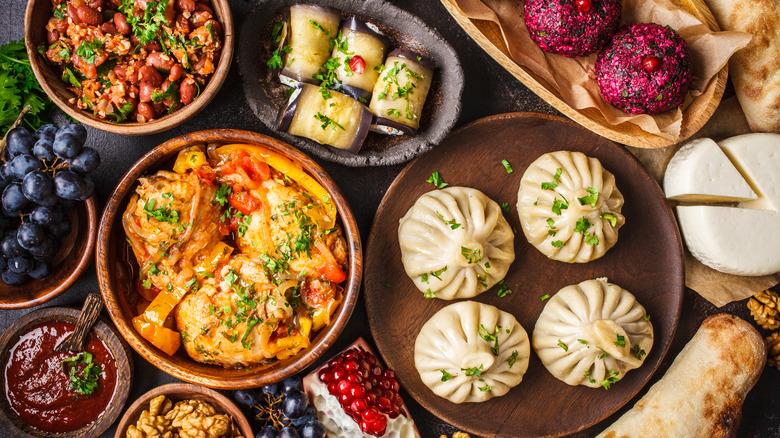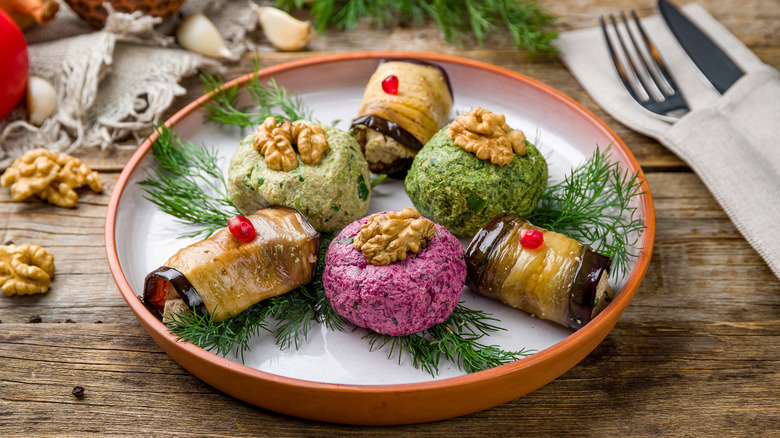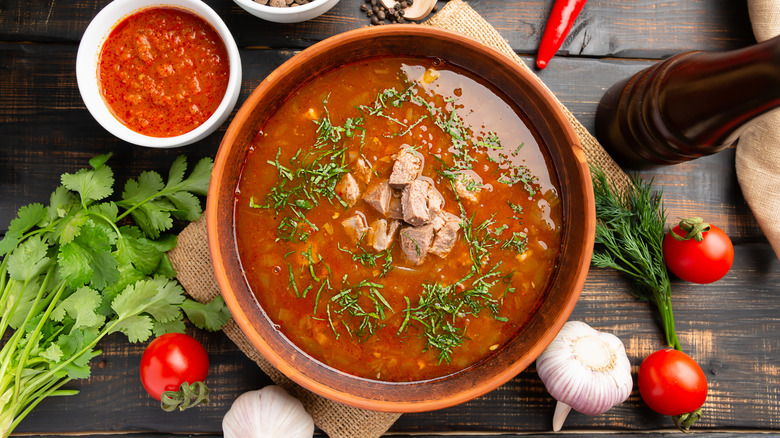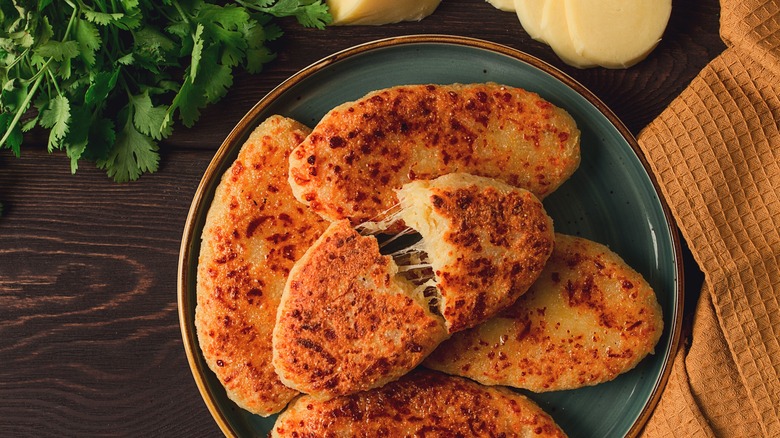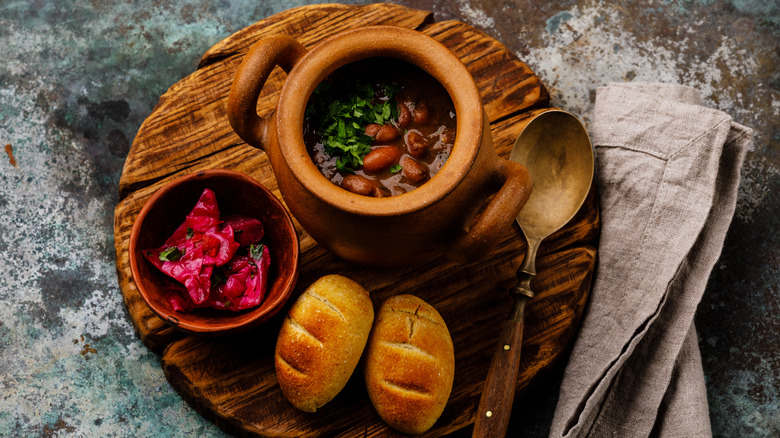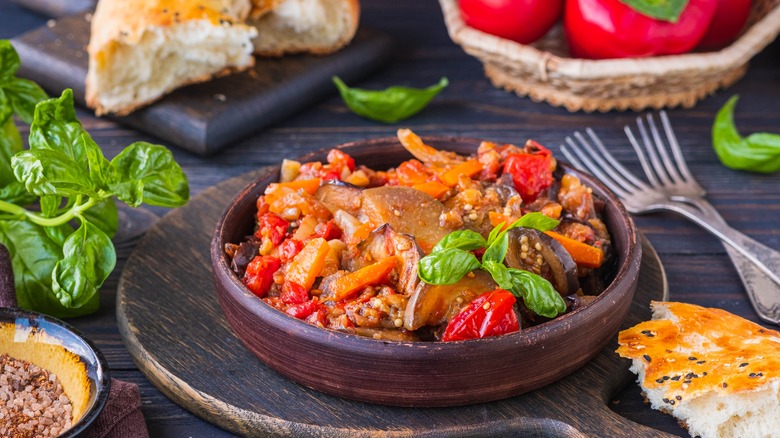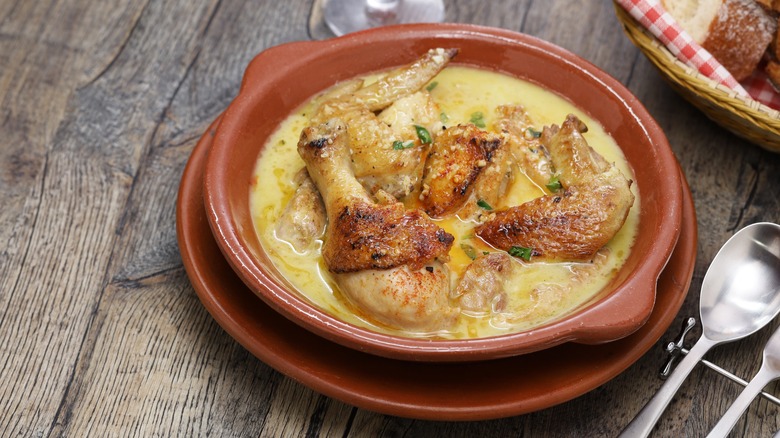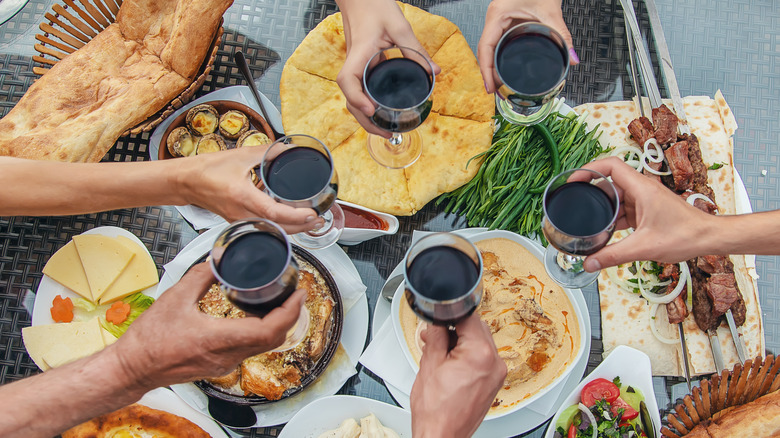13 Best Georgian Dishes You Must Try
If you haven't tried Georgian cuisine, you're missing out. Georgia has a rich culture and culinary tradition — and it's almost impossible to separate the two. After all, Georgia is a food and wine country. Located at the intersection of Asia and Europe, Georgian cuisine carries influences from both. However, Georgian food is entirely unique — and highly underrated. Georgians take comfort cuisine to the max with cheese-filled bread, nutty stews, and giant dumplings. The dishes might be a mouthful to pronounce, but we'd worry more about the size of your appetite. In this country, meals are heavy, and portion sizes are large.
Georgian feasts, or "supras," involve copious amounts of food and drink. At these tables, a toastmaster (referred to as a "tamada") gives frequent toasts — with sentimentality increasing by the glass (via FoodFunTravel). If you're ever asked to join one of these supras, you should definitely revel in the experience. But you don't need to wait for an invitation to try Georgian food. It's might be one of the world's best-kept secrets, but luckily we're here to bust it wide open and share some incredible dishes you can whip up at home.
1. Khachapuri
Khachapuri is the national dish of Georgia. Broken down, the word translates to "cheese curds" and "bread." It is essentially just that: Cheese and bread, two staples in the Georgian diet. As a symbol of the country, you'd be hard-pressed to enter a souvenir shop without seeing khachapuri magnets or keychains.
While all Georgians eat khachapuri, the dish varies by region. Imeretian khachapuri is the most popular and resembles a circular calzone stuffed with salty Imeretian cheese. It's sliced into pie-like wedges and meant to be shared — like many Georgian dishes.
Although Imeretian khachapuri is more popular within the country, foreigners go wild for the Adjarian version. Adjaruli khachapuri is shaped like a cheese boat, which feels appropriate since the region borders the Black Sea. This Instagrammable creation looks like a doughy canoe filled with cheeses and baked till golden brown. Once out of the oven, it's topped with a fresh egg yolk and a generous dollop of butter. The result is a warm, cheesy, eggy pie. Mix the goodies around, dig in with a fork, or break off the crust and dive into the gooey middle. However you slice it, this national dish is an absolute must.
2. Khinkali
Khinkali are Georgia's dumplings. They're larger than Asian dumplings and take this comfort-food classic to the next level. They have delicate, flour-based skin which is wrapped around savory goodies and knotted at the top. Ground meat is the most popular filling, but cheese, greens, mushrooms, or mashed potatoes are all common as well. When served, khinkali looks like a carefully-tied treat just waiting to be unwrapped.
However, there's an art to consuming these giant dumplings, and doing so incorrectly could provoke some funny looks. Traditionally, you'd hold the khinkali upside down by its nub. Bite into the soft center while simultaneously sucking out all the salty juices. You wouldn't want anything to go to waste after all. But although you should savor each delectable bite, don't consume the topknot. It's customary to discard these nubs and, in some circles, even competitively count them. So if you find yourself at a Georgian restaurant, order plenty and let that competitive spirit shine. Just make sure not to commit a khinkali faux pas in the process.
3. Pkhali
Georgian cuisine isn't all starch and cheese. The people of this country love their nuts and veggies, and pkhali is the perfect example. Pkhali is an appetizer made from ground walnuts, vegetables, and herbs rolled together to form soft, colorful balls. Garnished with bright pomegranate seeds, this beautiful dish gets bonus points for presentation.
Beet and spinach are the most common pkhali, but the eggplant version deserves special mention. Eggplant pkhali, more commonly called badrijiani nigvzit, is a garlic-walnut paste wrapped in thin strips of grilled eggplant.
All pkhali has a paté-like texture and is usually served as a cold side dish. You'd be hard-pressed to find any Georgian spread without a few servings of pkhali. Although many restaurants use meat grinders to blend all the ingredients, you can also attempt this dish at home. Use a food processor, and don't skimp on the garnish. Regardless of your choice of vegetables, your pkhali platter is sure to brighten up any table and impress some guests.
4. Shoti
If you walk the streets of Georgia, you'll pass local bakeries and smell freshly baked bread wafting from the doorways. The country is full of small bakeries around every corner, so the light, sweet smell of yeast is commonplace.
Shotis puri, or simply shoti, isn't your average bread. These canoe-shaped loaves are made with white flour, salt, water, and yeast. Once mixed and thoroughly kneaded, the dough is carefully plastered along the sides of a tone (a deep clay oven resembling an open-topped tandoor). After brief cooling, bakers wrap the loaf in paper and it's ready for sale. When freshly-made batches appear, expect lines out the door as people rush to get their shoti while it's hot.
Shoti takes on the shape of the curved walls of the tone oven. The outside is tough while the inside is soft, making it perfect to soak up all the sauces and flavors of Georgian dishes. Shoti is served with every meal, and while a loaf is meant to be shared, you'll definitely need more than one for a group.
5. Ghomi
Ghomi is to Georgians what grits are to, well ... the other Georgians (from the United States). Ghomi is a porridge-like dish from the Samegrelo province made from cornmeal, cornflour, and water. Ghomi is all about simplicity and texture. It's not so much a stand-alone item as it is an excellent base or bread substitute. It's often served with a slice of cheese or sauces but also pairs perfectly with soups and stews.
Ghomi is easy to make and can be found everywhere in Georgia. But if you want to elevate things, try its sister dish, elarji. This meal is ghomi with cheese already mixed in. Making a giant pot of elarji is quite a sight to behold. To test the insanely elastic texture, chefs often dip a serving spoon in, lifting it as high as possible without breaking the elarji stream. The higher they can go, the cheesier it is. And in a country that loves its cheese, this is a very, very good thing.
6. Kharcho
Kharcho is a traditional Georgian soup made of beef or chicken in a rich, flavorful sauce. The soup calls for fatty chunks of meat, which give it a satisfying, umami quality. Georgians aren't shy with spices, and this soup uses a blend called khmeli suneli. Commonly sold as "kharcho seasoning," this plethora of spices includes fenugreek, basil, parsley, fennel, and coriander to name a few (via Tamada).
Kharcho can vary depending on the chef and region. If you order kharcho at a restaurant, you'll probably get a tomato and plum-based broth with chunks of veggies and meat. However, if the lesser-known Megrelian kharcho is on the menu, we'd highly recommend it. This thick meat stew comes in a warm walnut puree. It's reminiscent of a nutty curry and is one of the heartiest Georgian meals out there — which is saying a lot. But why stop there? Go nuts and pair this dish with elarji for the ultimate comfort food combo.
7. Chvishtari
Georgians love their bread, but they don't just create the wheat-based variety. Mchadi is the country's cornbread and is made with cornmeal, salt, and water. However, why stop there? This is precisely how the Svanetian and Megrelian people felt. In these provinces, cooks began adding a salty cheese, and we're oh-so-happy they did. Nowadays, they sometimes add milk or eggs to enhance the chvishtari's soft, melt-in-your-mouth texture.
Unlike the fluffy American cornbread, chvishtari comes as flat, oval discs. It's pan-cooked until crispy and golden and is best served hot and fresh. The cheese can be mixed into the batter, making it evenly dispersed for those consistently cheesy bites. Alternatively, a large chunk can be sandwiched in the middle just before frying. The delicious result: Grilled cheese meets crispy cornbread.
Chvistari is satisfying on its own and works well as a bread substitute. It's usually gluten-free, and you can find it at almost all Georgian restaurants. If not, mchadi is sure to be on the menu. But, again: Why get cornbread when you can get cheesy cornbread? And if you're attempting this dish at home, rest assured that it's easy to make. It might take some time to get the consistency right, but it's well worth the effort.
8. Lobio
Lobio is a vegan's dream. The dish is naturally free of animal products yet super hearty and satiating (a common theme with Georgian cuisine). The word "lobio" translates to "beans" and can be used to describe beans in virtually any form.
However, when discussing Georgian dishes, lobio refers to a specific bean-based meal. In this stew, beans are cooked, then combined with walnuts, onions, garlic, cilantro, and spices. Many beans can be used, but cold varieties generally opt for kidney beans, while hot versions often use pinto beans. Lobio is served in a single-serving clay pot with mchadi (Georgian cornbread) and pickled veggies on the side.
The ingredients are simple and natural. Yet, they yield a surprisingly meaty and smoky flavor despite being vegan. If you do want to add meat, by all means, go for it. It's not uncommon for some Georgian restaurants or families to add pork, and lobio tastes amazing with thick chunks of bacon.
9. Ojakhuri
If you're a meat and potatoes person, this dish is for you. Ojakhuri consists of chopped meat, potatoes, onions, and salt and pepper. The ingredients are simple, but it's all about timing. The potatoes are cooked separately from the veggies and meat and combined at just the right moment. As a result, the meat and potatoes end up crispy on the outside and tender in the middle. It's a delightfully oily dish heavy on that cooked onion flavor.
Pork is the meat of choice in ojakhuri, and the dish should include a mixture of lean and fatty pieces. This way, ojakhuri retains those naturally rich juices that make our mouths water in anticipation. If you don't eat pork, a veggie version with mushrooms is just as delicious. And if your mixture seems too dry, Georgian sauces should do the trick. Tkmeli is a sour plum syrup that adds just the right amount of acid. And if you love a kick, adjika is a spicy pepper paste that blends perfectly.
Ojakhuri comes from the Georgian word for family. This meal started in family environments and was so loved it eventually made its way into restaurants (via Bread & Wine). As such, it's on most Georgian menus but is also an excellent meal to make at home and the ingredients are super easy to come by. So if you want to try cooking some Georgian cuisine, start with this family-friendly dish.
10. Ajapsandali
Ajapsandali is Georgia's ratatouille and is known for its salty, robust flavor. It's made of eggplant, tomatoes, bell peppers, garlic, onions, and a generous helping of herbs.
It's a forgiving dish and ideal for experimentation. You can add veggies like potatoes and zucchini or spice things up with some hot chilis. Chopping the multitude of veggies might seem laborious, but once the grunt work is completed, you can sit back and let them cook down to a thick jammy consistency. It's a hard dish to mess up, and everyone has their own twists on the classic recipe.
Ajapsandali makes a great vegan dish all year since it can be consumed hot or cold. People love a nice chilled serving on a hot summer day. Regardless of temperature, the best way to eat this dish is to sprinkle some fresh cilantro on top and scoop it up with shoti bread.
11. Shkmeruli
Shkmeruli is fried chicken in a creamy garlic sauce. According to Bread and Wine, shkmeruli was born from a hostess' quick thinking. With unexpected guests and little in the kitchen, she managed to whip up this culinary masterpiece. It's no surprise new dishes are created in a culture of hospitality. Georgians will go to great lengths for their guests. It would be a shame to let anyone leave hungry, and shkmeruli definitely takes care of that.
A shkmeruli recipe calls for chicken, garlic, and dairy. Chicken cuts are left on the bone and browned. The creamy garlic sauce is made separately from milk and butter, but people have also added sour cream. Before serving, the chicken and sauce are combined in a ketsi, a clay baking dish that does a great job of keeping things hot. If you can't get your hands on a ketsi, a cast-iron skillet is a good replacement.
Shkmeruli is the ultimate garlic bomb. And if you love creamy dishes, don't deny yourself this pleasure. The chicken absorbs all the creaminess, and if that's still not enough, put some bread in the shkmeruli early on. Let it soak up all that garlicky goodness before you come back for it.
12. Churchkhela
Colorful strings of churchkhela dangle from street kiosks all over the country. These snacks are shaped like candles and have a similar waxy-looking exterior. But don't let the unique appearance fool you: With a sweet and chewy outside and a crunchy middle, these Georgian candies are a must-try.
To make churchkhela, nuts are threaded onto a string. Walnuts and hazelnuts are the most common, although you can create churchkhela with a whole host of nuts and dried fruits. Separately, fresh fruit mush and flour are mixed into a paste and gently heated. Dip the strings into the paste and swirl them around for a generous coating. Hang them to dry overnight, and voila — you've got churchkhela. You can cut these sweet candles into pieces or bite straight into them like candy bars.
Although it's easy to find churchkhela in Georgian markets, most strings are homemade. During the harvest season in late fall, excess nuts, juice, and grapes are put to use to make this dessert. Families head to their farms and tend to the land, returning to the cities with enough churchkhela to last the season. Tradition, food, and family are everything here — and churchkhela is the sweet representation of all three.
13. Wine
Although not technically food, a list of Georgian cuisine wouldn't be complete without wine. After all, this country is the birthplace of viticulture, with the science to prove it. According to National Geographic, archeologists have traced the earliest signs of winemaking, dating back 8,000 years, to modern-day Georgia.
And today, Georgia might have the most unique wine on the market. It has a history of making wine in qvevri, earthenware vessels buried underground, and the country cultivates over 525 indigenous grape varieties (via Vinography). That's a lot of wine you've probably never tried — or even heard of — but definitely should. Some Georgian-style wines are made from white grapes fermented with the stems and skins attached, resulting in a beautiful amber color. If you prefer red wines, we'd recommend the dry, full-bodied saperavi or the semi-sweet kindzmarauli. With an endless selection of Georgian wines, you're sure to find one you love.
Wine is a foundational part of Georgian meals. And in this country, when a glass is raised, it's time for yet another toast, to life, family, food ... or whatever is fitting at that moment. Because here, eating is a joyous occasion, and all cuisine deserves a celebration. So cheers to Georgian food and wine, and as the locals would say, "Gaumarjos!"
